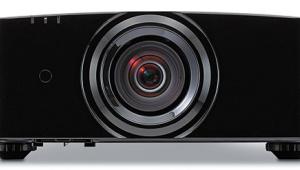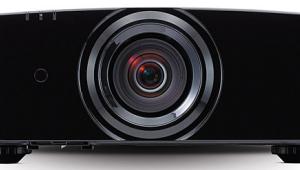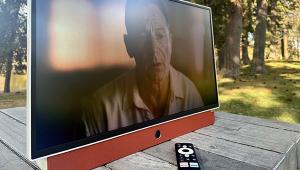Epson 5030UBe 3D LCD Projector Page 2
Other setup options I took advantage of when reviewing the 5030UBe (there are lots of ’em) included a Panel Alignment control in the Extended submenu that lets you align the projector’s red, green, and blue panels for a crisper-looking image; a Super-resolution adjustment that when used sparingly (I left it set at +1) adds fine detail enhancement minus ringing artifacts; and a Frame Interpolation mode with Low, Normal, and High settings to reduce motion blur.
Performance
It had been a few years since I last reviewed an LCD projector, so I wasn’t sure what I’d be in for once I finally stopped messing with test patterns and sat down to watch a movie. To sum up briefly: wow. Black levels were deep, and shadows showed plenty of near-black detail. The horizontal bars in letterboxed films also looked black or nearly so, allowing them to blend seamlessly with the dark wall behind the projection screen in my room.

Given our experience last year with Epson’s 5020UBe, I wasn’t surprised to see that the new model was capable of serious light output: I measured 60 foot-lamberts in Dynamic mode, though in THX 2D mode with settings adjusted for maximum contrast (no white clipping), the projector ended up putting out around 17 ft-L.
When I watched one of my reference discs, 2001: A Space Odyssey, shadows in the pre-human cave scene were inky black, and starfields in outer-space shots popped to a satisfying degree. When I switched to a recent Blu-ray release, The Wolverine, the Epson’s excellent contrast made a scene where Logan and Yukio speed through Tokyo at night a fast-motion swirl of punchy, bright lights against an endlessly deep background. And in a later scene where Logan storms the Yashida family compound to retrieve Mariko, patches of moonlit snow showed a wide range of white detail. Plenty of shadow detail could also be seen in building exteriors half-lit by the warm glow emanating from windows.
Colors on the Epson were for the most part accurate out of the box in the default THX mode, with skintones looking natural on the handful of reference discs I checked out. The stylized color palette of The Wolverine was also displayed to good effect, with Yukio’s plum-red hair and Logan’s ruddy complexion looking rich without being too saturated.
Once Epson’s active 3D glasses were fully charged (via the USB port on the HDMI transmitter), syncing them with the projector was a simple matter of sliding a pairing switch at the top of the frames (and then dismissing an onscreen warning saying that 3D video can make you vomit, or something like that). With Pacific Rim playing, an overhead shot of Raleigh balanced high up on an I-beam near the top of the Alaskan safety wall showed impressive 3D depth, with the bars extending way into the frame almost giving me vertigo. And shots of the massive complex where the anti-Kaiju resistance fighters prep robots for battle was solid enough to give a sense of the stadium-like space. I did see a slight amount of crosstalk in tough 3D test discs like Hugo, but that was the lone instance, and it wasn’t even as bad as I’m used to seeing with most flat-panel TVs. Meanwhile, brightness in THX 3D mode with the High 3D Brightness setting selected was definitely adequate for my setup.
Turning on Epson’s Frame Interpolation feature helped bump motion resolution up to 1,000 lines with test patterns but also added a degree of soap-opera effect to movies when set to High or Medium. There was almost no visible soap opera effect with the Low mode active, however, so I ended up leaving that setting on for most of my viewing and had no complaints.
Conclusion
Epson’s 5030UBe surprised me with its excellent contrast—I didn’t think I’d ever see blacks this deep come from an LCD projector. Otherwise, the 5030UBe’s all-around great performance in both 2D and 3D modes and an ample brightness reserve make it a solid choice for a midrange home theater. And at $2,899 ($2,599 if you opt to do without the wireless HDMI option), it’s an affordable one as well.
- Log in or register to post comments






























































